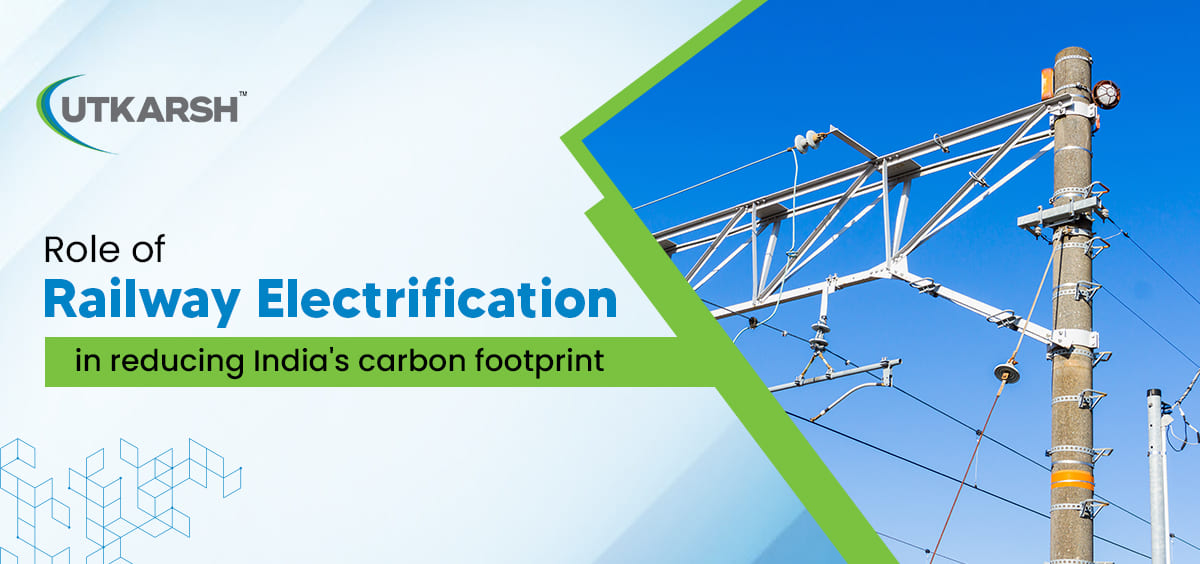Role of railway electrification in reducing India carbon footprint

Electrification of the Indian railways is meant to improve energy efficiency and reduce greenhouse gas emissions. Before the electrification of railway systems in India, diesel trains were the primary mode of transportation on the railways. Let us first take a brief look at the history of diesel trains and the subsequent electrification of railway systems in India.
The use of diesel engines dates back to the late 1800s. However, diesel trains didn't come to India until the mid 20th century when steam locomotives had become difficult to handle. The first diesel train YDM-1, meant for freight transportation was designed by the American Locomotive Company. However, diesel trains posed major problems with regard to their impact on the environment. They emit loud noises that cause noise pollution. They also emit poisonous gases in the environment such as nitrogen dioxide and particulate matter which causes air pollution that affects human health. Not only that, it also impacts climate change by releasing greenhouse gases such as methane and carbon dioxide. Oil from diesel trains can leak and pollute the soil and nearby water bodies killing fish and other aquatic life. This in turn can affect the entire ecosystem.
As a result, the Government of India decided to electrify the railway systems in India. It is a part of GoI's Nationally Determined Contributions (NDCs), which targets to reduce emissions by 33%. Since the transport sector is one of the most pivotal parts of the economy, the government has focused on substantial mitigation of pollution in this area. It is also meant to be a contributing factor to the Swachh Bharat Mission. The idea behind the electrification is to improve energy efficiency and reduce emission of greenhouse gases for the country. In fact, India achieved 100% electrification of its east coast, southeastern, eastern and central eastern railway zones in September 2022. Electrification of the railway systems is a critical factor in India's efforts to reduce its carbon footprint.
It reduces poisonous emissions:
India is working towards reducing its greenhouse gas emissions and achieving an overall equilibrium between emissions produced and removed from the atmosphere. As a result, the Government of India has urged the companies and automobiles to find alternatives to fossil fuel energies. Additionally, afforestation is adopted to restore the balance by removing carbon from the atmosphere. In this context, the electrification of railway systems is a significant step towards achieving the country's emissions reduction targets. By minimising the use of diesel-powered trains, complete electrification of the railways in India could result in the reduction of an estimated 15 million tonnes of carbon dioxide emissions.
It increases freight capacity:
With lesser need for refuelling, the railway authorities have enhanced their focus on increasing the capacity and connectivity. Electric trains have more space and operate faster. They can carry more freight unlike diesel trains that make several trips for transportation of heavy goods. These trains can travel longer distances over a shorter span of time as they are faster and more efficient. Electric trains are also low maintenance and do not require frequent change of mechanical parts. They are a sustainable mode of transportation and do not harm the environment.
Significant increase in passenger load:
Electrification of railways has significantly increased the passenger capacity of the trains. The electric locomotives operate faster and can ply across larger distances. These trains barely face any delay and reduce railway congestion. These trains have faster acceleration and deceleration, which makes them ideal passenger trains. Railway electrification has also reduced the usage of fossil fuels which has made the tickets cheaper. As a result, more people are opting for trains as their mode of transportation. They emit less noise, are more comfortable and are better suited for faster transportation between major cities.
Reduces dependence on fossil fuels:
Fossil fuels are non-renewable sources of energy, and their increased use has depleted the earth's resources while causing harmful emissions into the atmosphere. The use of electric trains reduces the need for fossil fuels. This is a contributing factor to save the environment.
Reduces levels of pollution:
Electric trains are an excellent example of how reducing the usage of fossil fuels can lead to a cleaner environment. These trains emit no harmful pollutants, making them a much cleaner mode of transportation. Unlike diesel-powered trains, electric trains emit no disturbing noises or mechanical vibrations, thereby reducing noise pollution. They also use renewable energy sources that are not only cost-effective but also more efficient in the long run. Additionally, these trains do not use any harmful chemicals that can run off into water bodies and contaminate them, contributing to cleaner water bodies.
Looking for information on the railway electrification system?
Get in touch with Utkarsh India Limited. We are an approved vendor of CORE PART I for the manufacture and supply of a wide range of railway electrification structures, including portals, masts and beams. We operate two hot dip galvanising plants that each have a 12.5 metre long facility. These plants use high-grade zinc with a purity of 99.995%, sourced from reputable brands such as SAIL and Hindustan Zinc. We employ approved welders and utilise necessary equipment to ensure quality control. Our design department is equipped with the latest hardware and ERP system to meet the needs of our customers. Additionally, we provide tower-wise bundling to facilitate efficient installation at the erection site.